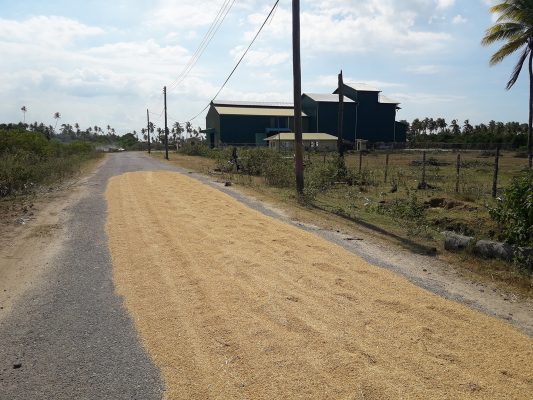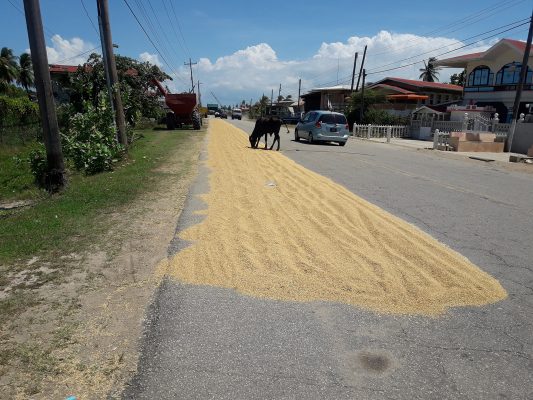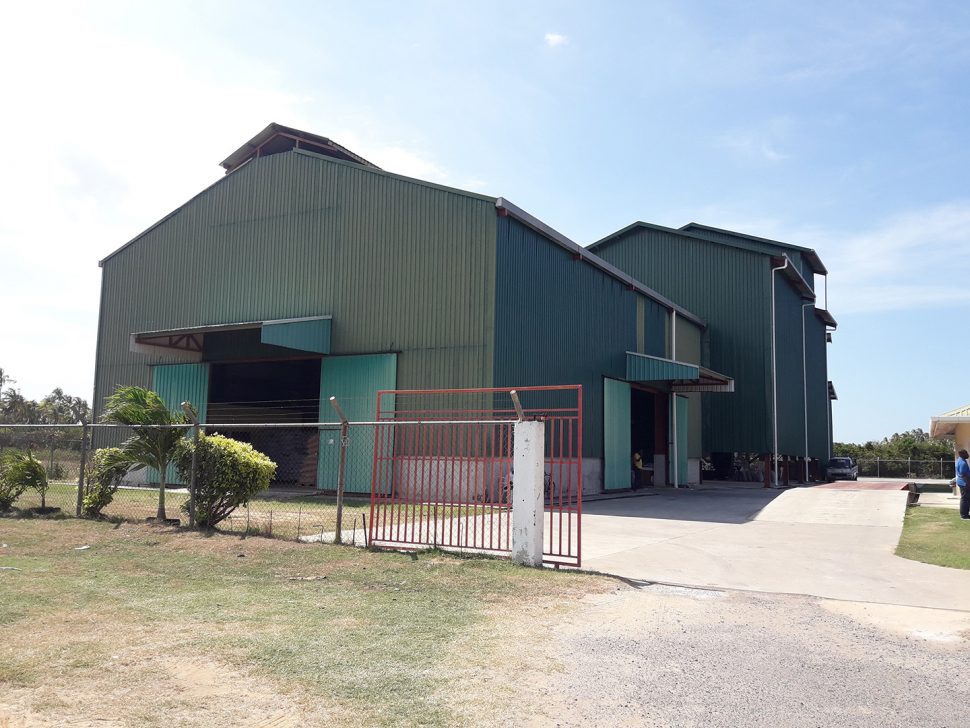The Prime Minister’s representative in Region Six, Gobin Harbhajan, is encouraging rice farmers throughout the region to begin using paddy drying facilities instead of drying their paddy along the roadways.
Placing paddy along roadways not only obstructs traffic but endangers road users.
Harbhajan told Stabroek News that there is a major seed paddy facility, located at Number 56 Village, Corentyne, which is not being used to its potential because farmers are accustomed to drying their paddy along the roadways without objection.
However, Harbhajan stressed that it is time for farmers to be responsible and considerate. He explained that only around 21 farmers, hailing from the Upper Corentyne to Whim, Corentyne, are presently making use of the facility to dry and clean their paddy.

By his calculations, farmers are spending more money to dry their paddy on the road than if they were to use the facility. He explained that initially, the cost per bag at the facility was $500, however, after complaints from farmers the price was reduced to $340 per bag. He related that the facility is able to dry and clean over 290 bags an hour.
“It’s not only drying the seed paddy, they are also cleaning it too,” he noted. “It’s better for the farmers; drying it on the public road is very dangerous.”

He also stated that farmers who use the facility have told them that “the production has increased in the field from 30 bags an acre to approximately 40 bags and over” after having their paddy cleaned at the facility. He also explained that at the facility a test is being done to ascertain the quality of the paddy and what to expect before proceeding with drying and cleaning, which helps farmers to make an educated decision on the way forward and save time and money as a result.
“I’m appealing to the farmers drying paddy on the public road: just make a booking with the manager and he can make arrangements for you,” he stressed.
The facility, which was commissioned in 2015 and is being run by the Guyana Rice Development Board, also has a drying floor, which is free to farmers who do not wish to use the facility’s machines to dry and clean their paddy.
Additionally, Harbhajan explained that there are other mill operators in the region that farmers can meet with to discuss alternative means of drying the crop, instead of using the roadways. He had also stated that there are several other drying floors throughout the region in areas such as Bengal Village on the Corentyne and Lesbeholden and Yakusari, located in Black Bush Polder.
More facilities needed
Notably, when Stabroek News met with farmers who were drying their paddy along the road just outside the facility, some claimed that they were unaware of its purpose. Others said it is too expensive to bag the paddy and transport it to the facility.
Meanwhile, Rice Producers’ Association President Leekha Rambrich, in an invited comment, called on the government to work on placing more drying facilities and floors within the region.
Rambrich noted that while drying paddy on the road is against the law, the region is an agriculture-based one and “this region needs roughly over 60,000 bags of paddy and we don’t have the drying facility to do 60,000 bags of paddy, so farmers are forced to dry paddy on the road.”
He explained that in some areas where drying floors are located, farmers are also reluctant to use them because they believe that the paddy is dried faster on the road due to the intense heat. “They dry paddy on the road one day they finish dry it; they dry paddy on the floor it takes two days, so is more cost,” Rambrich added.
Rambrich did stress that if there are enough facilities to accommodate all the farmers, then they would have no choice but to stop drying paddy along the roadways. “I think before we implement the law, the government should step in and put the necessary drying facilities in place so that we can able to dry the amount of seed paddy,” he added.
He said to his knowledge the drying facility at the Number 56 Village, Corentyne, is able to dry 8,000 bags of paddy per crop. “8,000 out of 60,000,” he noted.
Additionally, he said farmers are always asked to be careful and not place other objects, such as bricks or barrels along the road, when drying their paddy. “We would not accept that but I want to challenge the authorities to tell me how much accidents [were] ever made by drying seed paddy on the road?” he questioned.
The issue as reported by Harbhajan is not confined to Region Six. Just recently, the Officer in charge of Traffic in ‘B’ Division, Timothy Williams, during an outreach held in Region Five, called on farmers to desist from drying their paddy along the road.
Williams had explained that in drying the paddy, farmers also place objects, such as barrels, to alert drivers to its presence on the road, further reducing the road width. Williams also pointed out that once paddy is placed on the road, animals will show up to eat the paddy, which is another major issue.
He too pleaded with farmers to come up with alternative areas to dry their paddy, and to stop placing objects along the roadways.
Williams also stressed that the police are working to have awareness programmes aired on television and community meetings hosted in order to educate farmers on the dangers of having their paddy dried along the roadways, and to come up with solutions for the way forward.






